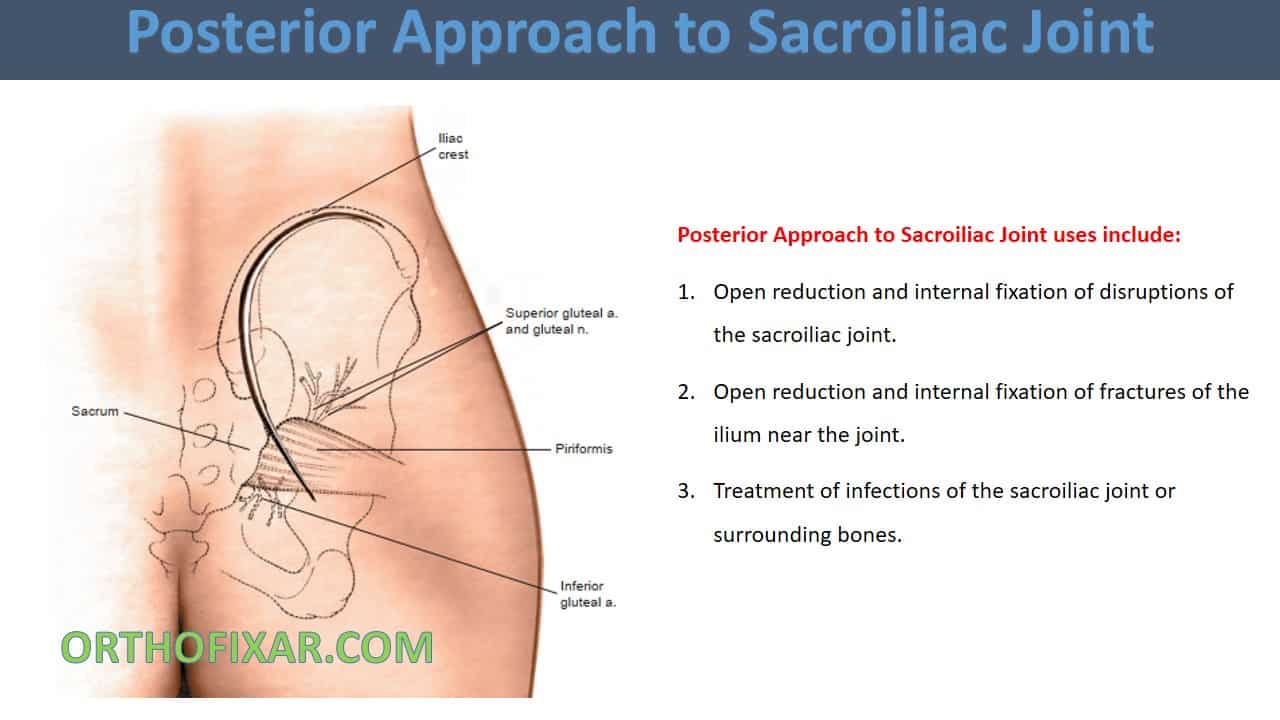Approach
Posterior Approach to Sacroiliac Joint

Posterior Approach to Sacroiliac Joint indications:
The posterior approach to sacroiliac joint is a simple, safe approach that does not endanger any vital structures.
Posterior Approach to Sacroiliac Joint uses include:
- Open reduction and internal fixation of disruptions of the sacroiliac joint.
- Open reduction and internal fixation of fractures of the ilium near the joint.
- Treatment of infections of the sacroiliac joint or surrounding bones.
The popularity of this approach has decreased with the increasing use of percutaneous screw fixation techniques.
It should be noted that reduction of fractures and dislocations is difficult through this approach, especially the correction of vertical displacement.
Position of the Patient
- Place the patient prone on the operating table.
- Position bolsters longitudinally to support the chest wall and pelvis; the bolsters should allow the chest wall and abdomen to expand without touching the table.
Landmarks and Incision
- Landmarks:
- Posterior iliac crest.
- Posterior superior iliac spine.
- Incision:
- Make a curved incision overlying the posterior iliac crest, beginning 3 cm distal and lateral to the posterior superior iliac spine.
- Extend the incision from this spot to the posterior superior iliac spine and then continue along the crest to its highest point.

Internervous plane
- There is No internervous plane for Posterior Approach to Sacroiliac Joint.
- Both the gluteus maximus and gluteus medius muscles must be detached partially from their origins, but their individual neurovascular pedicles are preserved easily.
Superficial dissection
- Divide the subcutaneous tissues in line with the skin incision.
- Cut down into the outer border of the subcutaneous surface of the iliac crest to reveal the layer of fascia that covers the gluteus maximus muscle.
- Detach the origin of the gluteus maximus muscle from the crest and carefully reflect the muscle downward and laterally.
- As the gluteus maximus muscle is reflected, the gluteus medius and piriformis muscles will be uncovered as they emerge through the greater sciatic notch.

Deep dissection
- Gently elevate the gluteus medius muscle from the outer wing of the ilium.
- The muscle cannot be elevated much anteriorly because its deep surface is tethered by its neurovascular bundle , the superior gluteal nerves and vessels.
- In cases of trauma, the ruptured sacroiliac joint or fracture is easily visible, but reduction is extremely difficult.
- To evaluate any reduction, detach part of the origin of the piriformis muscle from around the greater sciatic notch and insert a finger through the notch to palpate the joint from its anterior surface.
- The surface of the joint will feel smooth if it has been reduced.
Approach Extension
- The Posterior Approach to Sacroiliac Joint can be extended anteriorly and the gluteus medius and gluteus minimus muscles elevated from the outer side of the iliac wing.
- This will enable more extensive fractures of the wing and the ilium to be dealt with.
Dangers
The structures at risk during Posterior Approach to Sacroiliac Joint includes:
- Nerves:
- The inferior gluteal nerve.
- superior gluteal nerve.
- sacral nerve roots.
- Vessels:
- Branches of the superior and inferior gluteal arteries run with their respective nerves and also are in danger.
References
- Surgical Exposures in Orthopaedics book – 4th Edition
- Campbel’s Operative Orthopaedics book 12th
Last Reviewed
June 12, 2021
June 12, 2021
Contributed by
OrthoFixar
OrthoFixar
Orthofixar does not endorse any treatments, procedures, products, or physicians referenced herein. This information is provided as an educational service and is not intended to serve as medical advice.
Angle Meter App for Android & iOS
- Lifetime product updates
- Install on one device
- Lifetime product support
Orthopedic FRCS VIVAs Quiz
- Lifetime product updates
- Install on one device
- Lifetime product support
Top 12 Best Free Orthopedic Apps
- Lifetime product updates
- Install on one device
- Lifetime product support
All-in-one Orthopedic App
- Lifetime product updates
- Install on one device
- Lifetime product support

